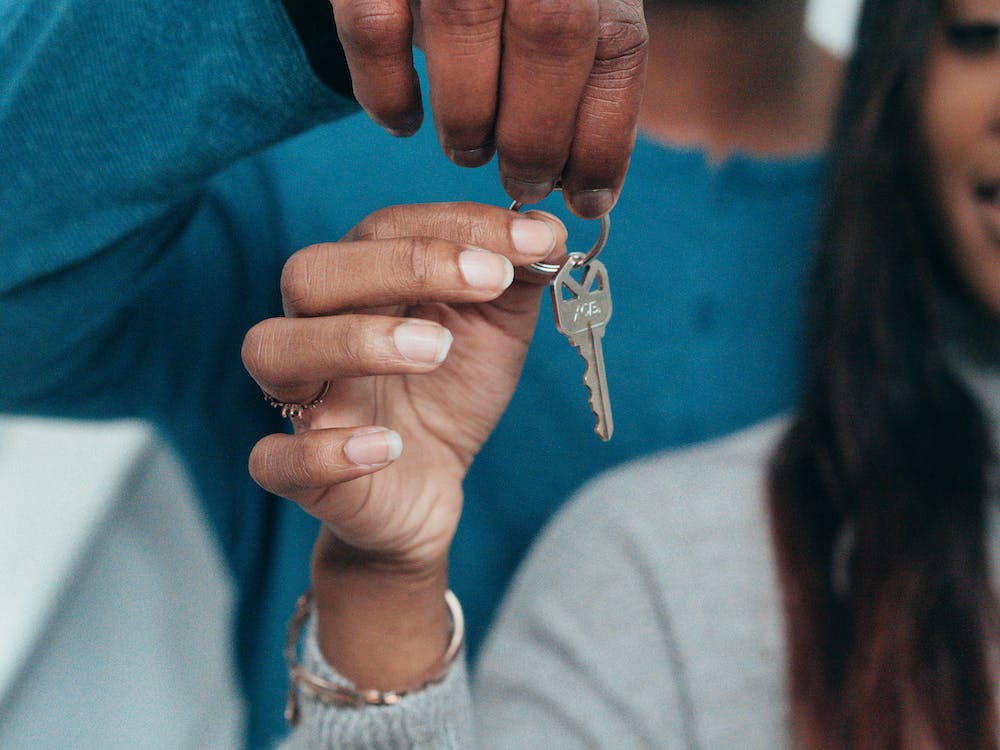Many people want to buy a home but think it’s impossible because they don’t have the money for a down payment. Traditionally, lenders require you to put 20% down.
But a 20% down payment adds up to a lot of money. For example, if you plan to buy a $150,000 home, you’ll need to come up with a $30,000 down payment. Many people can’t afford that, but fortunately, the 20 percent rule isn’t as common as you might think.
Is a buying a house with no money down possible?
The National Association of Realtors (NAR) reports that 39% of non-homeowners think they need 20% or more down, and 22% think they need 10% to 14%.
But neither of those statements is true. Many mortgage lenders will let you buy a house with as little as 3% down. Some lenders will let you skip the down payment altogether.
NAR also found that 61% of first-time homebuyers put down between 0 and 6%. So, it’s safe to say that a 20% down payment is no longer the norm. But unfortunately, many consumers choose not to pursue homeownership because they believe in this down payment myth.

Weighing the Pros and Cons of a No Down Payment Mortgage
Is there any reason to set a down payment at 20% when most homebuyers put less than 20% down? If you can afford it, the 20% rule is still a smart choice.
The more money you put toward your mortgage, the less debt you’ll have to pay off and the lower your monthly payments will be. Additionally, there are several downsides to putting less than 20% down: .
- Less favorable interest rates: If your interest rate is less than 20%, lenders may consider you a risky investment. They will take this into account when calculating your mortgage rate. Generally, if you make a smaller down payment, you may pay a higher interest rate.
- Higher Closing Costs: Closing costs depend on the size of your mortgage. So, the smaller your down payment, the higher your closing costs will be. However, if you live in a state where the seller usually pays closing costs, you may be able to get around this.
- Private Mortgage Insurance: Private mortgage insurance is a type of mortgage insurance designed for borrowers with less than 20% down. It protects your mortgage lender in case you end up defaulting on your loan.
The cost of Purchasing Manager’s Index can be as much as 1% of your total monthly mortgage payment. For a $150,000 mortgage, you end up paying $150 a month.
However, this may not be so bad, especially if you have a cheap mortgage. Once you hit 20% home equity, you can cancel your PMI and get rid of those extra payments.
How to Buy a House With No Money Down
Fortunately, there are several loan programs that don’t require a down payment. Here are five payment assistance programs that will help you buy a home with little or no down payment.
1.VA Loan
Veterans Administration loans are a valuable option for eligible veterans, active duty service members and certain surviving spouses. These government-backed loans offer a number of benefits that make homeownership more accessible and affordable through the use of a VA loan.
100% Financing with No Down Payment
One of the most important benefits of a VA loan is 100% financing, which means you don’t need a down payment when using a VA loan. This can save borrowers a lot of money upfront, making it easier to enter the real estate market.
No Private Mortgage Insurance (PMI) Requirement
Unlike conventional loans that require a down payment of less than 20% PMI, VA loans do not require PMI.This can save borrowers hundreds or even thousands of dollars a year in mortgage insurance premiums when using a VA loan.
VA Funding Fee
While VA loans offer many benefits, there is a one-time funding fee to help offset the cost of the program. The funding fee is 2.15% of the total loan amount for first-time VA loan applicants and 3.3% for those who apply thereafter.
This fee can be applied to the VA loan, reducing the borrower’s cash outlay. In some cases, borrowers may be exempt from paying the funding fee, such as those with service-related disabilities.
Certificate of Eligibility
To apply for a VA loan, borrowers need to obtain a Certificate of Eligibility (COE) from the Department of Veterans Affairs.The COE verifies the borrower’s eligibility for the VA loan program based on the borrower’s military service or, in some cases, his or her spouse’s military service.The COE can be requested through the Department of Veterans Affairs’ website, through the mail, or online through an approved lender.
Additional Benefits
VA loans also offer competitive interest rates, more lenient credit requirements and flexible underwriting guidelines compared to traditional loans. In addition, there are no early repayment penalties, allowing borrowers to pay off their VA loans early without incurring additional fees.
2.Navy Federal Credit Union
Navy Federal Credit Union has a loan program similar to that offered by the VA. It offers zero-down mortgages with no mortgage insurance. Navy Federal’s funding fee is only 1.75%.
Navy Federal offers a 30-year loan and a 30-year jumbo loan.The loan limit for the 30-year loan is $424,100, while the jumbo loan has a maximum limit of $1 million. However, you must be a Navy Federal member to qualify.
3.USDA Loans
If you want to move to a rural area, you may be eligible for a USDA loan. The USDA housing program is designed to help with rural development and targets low-income families. USDA loans offer 100% low-interest financing.
The following are eligibility requirements that must be met to qualify for a USDA loan:
- You must be within the USDA boundaries when buying a home: While this loan targets rural areas, some suburban areas may still qualify. You can take a look at this map on the USDA’s website to see if your location is within the USDA’s geographic boundaries.
- Your household income cannot exceed a certain threshold: This applies to everyone in the household, even if they won’t be listed on the mortgage. For example, if you have a parent living with you who receives Social Security, this will count toward the total income of all members of the household. Maximum household income varies by state and county, so you can find out if you qualify here.
4.Lease-Option
The Lease-Option (also known as Rent-to-Own) allows you to rent a home with the option to purchase it at a predetermined price after a certain period of time. A portion of your monthly rent can be used to pay the purchase price or down payment. This is a solid option if you need more time to save on a down payment or improve your credit.
5.Seller Financing
In some cases, the seller may be willing to finance the property for you, allowing you to purchase the home without a traditional mortgage. This arrangement usually requires a contract outlining the terms of the loan, including the interest rate, payment schedule, and any possible penalties.
Seller financing may be a viable option if you have a close relationship with the seller or if the seller is having trouble selling the property.
6.crowdfunding
Crowdfunding is a way to raise money from multiple individuals, usually through an online platform. You can launch a campaign to raise money for your down payment or even the entire purchase price. This method may work best if you have a strong group of friends, family and supporters who are willing to contribute to your home buying goals.
7.Shared Equity Agreements
An equity sharing agreement involves working with an investor who provides part or all of the down payment in exchange for a percentage of ownership of the property. When the property is sold or refinanced, the investor receives a return on their investment based on the agreed upon equity share. If you can’t afford a down payment but are willing to share in the future appreciation of your home’s value, this may be an attractive option.
8.Housing Assistance Programs
There are many local, state, and federal housing assistance programs that provide grants, low-interest loans, or other forms of financial support to help qualified individuals purchase a home without a down payment. These programs often have specific requirements, such as income limits, property location, or first-time homebuyer status. Be sure to research and apply for any programs you may qualify for.

Low Down Payment Loans
If you don’t have the money to buy a house, but can make a small down payment, consider these low down payment options that can help make homeownership easier.
1.97% LTV Mortgage
The 97% LTV Mortgage is a loan program offered by Fannie Mae and Freddie Mac to first-time homebuyers that requires a minimum 3% down payment and private mortgage insurance.
Here are the guidelines for the program:
- Your credit score needs to be at least 680
- One of the borrowers must be a first-time homebuyer
- Manufactured homes are not allowed
- Gifts, grants, and other funds may be used for the down payment
2.Federal Housing Administration (FHA) Loans
The Federal Housing Administration (FHA) was established in 1934 to lower the mortgage qualification requirements. This government-backed mortgage program offers flexible requirements and is an attractive option for first-time homebuyers.
Credit Score Requirements
The minimum credit score required to qualify for a Federal Housing Administration loan is 500. The exact down payment requirement depends on your credit score:
- If your credit score is between 500 and 579, you’ll need to make a 10% down payment.
- If your credit score is 580 or higher, you’ll have to make a 3.5% down payment.
Seller’s contribution
Federal Housing Administration loans allow sellers to pay up to 6 percent of closing costs. This can help reduce upfront costs for buyers, making it easier to pay for a purchase.
Mortgage Insurance Requirements
Mortgage insurance is required for Housing Authority loans to protect the lender in case the borrower defaults on the loan. However, once you build 20% equity in the home, you can refinance to a conventional loan to eliminate the mortgage insurance requirement.
Debt-to-Income Ratio
Federal Housing Administration loans accept higher debt-to-income ratios (DTI), allowing borrowers with significant existing debt to still qualify for a mortgage. The FHA typically requires a maximum DTI of 43%, but exceptions can be made for borrowers with compensating factors, such as substantial savings or a history of making large payments on time.
3.HomeReady Mortgages
The HomeReady Mortgage is a program designed by Fannie Mae for low and moderate income borrowers. It requires down payments as low as 3% and offers flexible underwriting guidelines, making it an attractive option for first-time homebuyers or those with limited credit history.
4.Home Possible Mortgage
Similar to the HomeReady mortgage, the Home Possible mortgage is a Freddie Mac program that allows for down payments as low as 3%. It is designed to help low- and moderate-income borrowers obtain homeownership and offers flexible underwriting guidelines.
5.State and Local Homebuyer Assistance Programs
Many state and local governments offer homebuyer and down payment assistance programs that provide grants or low-interest loans to help with down payments and closing costs. These programs often have income and property location requirements, so be sure to research and apply for programs in your area that may qualify.
Each type of low down payment mortgage has its own set of eligibility requirements and potential benefits. Be sure to research and compare these options to determine which one best fits your financial situation and home buying goals.
Preparing for Homeownership
Before you start buying a home, it’s important to be financially and mentally prepared. This section will cover tips for improving your credit score, creating a budget, and managing debt to make the home buying process smoother.
Tips for Improving Your Credit Score
Improving your credit score includes checking your credit report for errors and disputing any inaccuracies. Make sure you pay your bills on time and minimize outstanding debt. Keep credit card balances low, avoid opening new credit accounts, and consider asking for a credit limit increase without increasing your expenses.
Create a budget
Creating a budget involves tracking your income and expenses to better understand your spending habits. Categorize your expenses and set reasonable limits for each category. Allocate money for savings and investments, including down payments and emergency funds, and review and adjust your budget regularly as needed.
Managing Debt
Managing your debt effectively includes prioritizing high-interest debt and paying more than the minimum payment. Consider debt consolidation or refinancing options to secure lower interest rates. Avoid taking on new debt before applying for a mortgage and create a debt repayment plan you can stick to.
Understand the total cost of homeownership
Understanding the total cost of homeownership means considering property taxes, insurance, maintenance and utility costs. Estimate homeowners association (HOA) fees (if applicable) and consider the cost of renovating and updating your home. Prepare for possible future increases in expenses, such as property tax increases.

How to Choose the Right Mortgage Option?
There are a variety of mortgage options available, and choosing one that fits your financial needs and long-term goals is crucial. This section discusses factors to consider when choosing a mortgage, such as loan term, interest rate and mortgage insurance.
Fixed-Rate vs. Adjustable-Rate Mortgages
Fixed-rate mortgages have a consistent interest rate over the term of the loan, providing stability and predictable monthly payments. In contrast, adjustable-rate mortgages (ARMs) have an initial fixed-rate period followed by periodic rate adjustments, which can result in a lower initial payment but potentially higher rates over time.
Mortgage Term: 15-Year vs. 30-Year
Mortgage term plays a crucial role in determining the total cost of a mortgage.15-year mortgages typically have lower interest rates and allow for faster equity buildup, but require higher monthly payments.30-year mortgages offer lower monthly payments, but pay more interest over the life of the loan.
Mortgage Insurance Considerations
Conventional loans with less than 20% down may require PMI. federally backed loans, such as those from the Federal Housing Administration, Veterans Administration, or U.S. Department of Agriculture, may have different insurance requirements or fees.
Assessing Your Long-Term Goals
When choosing a mortgage, consider how long you plan to live in the home and whether your financial situation or housing needs will change. Evaluate the potential for the home to appreciate in value and the impact on your future financial goals.
Planning Your Next Steps
Assess Your Financial Situation
How much you choose to put down is a personal choice. If you’re ready to own your own home, but know that a 20% down payment isn’t feasible for you, there are many options to help you.
The best place to start is to look at your monthly budget and see what you can afford. Use a mortgage calculator to reverse engineer your goals and find your ideal home purchase. Consider factors such as property taxes, insurance and maintenance costs, and your current debt.
Get Pre-Approved
Before you start looking for a home, get pre-approved for a mortgage. This will give you an idea of how much you can afford, and it will show sellers and realtors that you are a serious buyer.
In order to get pre-approved, you’ll need to provide the lender with documents such as pay stubs, bank statements and tax returns. They will then evaluate your credit score and financial history to determine how much they are willing to lend you.
Shop Around for the Best Mortgage
Shop around for the best mortgage rates and terms. Don’t settle for just the first lender you meet. Compare different lenders and loan programs to find the best fit for your financial situation. Look for competitive rates, low fees and flexible repayment terms.
Work with a Knowledgeable Real Estate Agent
A good realtor can help you find a home that fits your needs and budget. They’ll also guide you through the home buying process, reducing stress and making sure you don’t make any costly mistakes.
Attend First-Time Homebuyer Classes
Consider attending a first-time homebuyer class or seminar. Many local organizations and government agencies offer educational resources for first-time homebuyers. These classes can help you learn the ins and outs of the home buying process and provide you with the knowledge you need to make an informed decision.
Save for Unexpected Expenses
Even if you don’t need a down payment to buy a home, it’s a good idea to save some money for unexpected expenses. These expenses may include moving costs, home repairs, or the cost of renovating your new home.
Build an Emergency Fund
In addition to saving for unexpected expenses, it’s important to have an emergency fund. This should be enough money to cover three to six months of living expenses in case you lose your job or face another financial emergency.
Be Patient and Stay Disciplined
Buying a home is a complicated process, and finding the right home and secure financing can take time. Stay focused on your goals, keep a tight rein on your spending, and remember that homeownership is a long-term investment.
Conclusion
Buying a house without a down payment is possible, but it may not be the best option for everyone. Consider your financial situation, your long-term goals, and the various mortgage options available before deciding on a zero-down mortgage. With careful planning and preparation, you can realize your dream of homeownership even if you don’t have a large down payment saved up.




